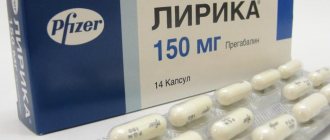Citalopram is a Russian-made antidepressant classified as a serotonin reuptake inhibitor.
It is used in the treatment of mental disorders in patients over eighteen years of age.
It is often accompanied by adverse reactions and can be addictive, so therapy should be supervised by a doctor.
Tradename
May be produced under several trade names:
- Sedopram;
- Oprah;
- Umorap;
- Citalift;
- Pram;
- Siozam;
- Citalorin;
- Cipramil;
- Cytol;
- Tsitalek;
- Citalopram hydrobromide.
Regardless of the trade name, it is dispensed from pharmacies strictly according to a prescription from a neurologist.
Instructions for use
Taken once a day, orally after meals, with plenty of water.
The appointment time (morning, afternoon or evening) is determined by the doctor individually for each patient.
Dosage:
- for depressive syndrome: at the beginning of therapy, a minimum dose of 20 mg is prescribed, later it can be increased to 40 mg;
- for panic attacks: during the first week of therapy, 10 mg is prescribed, then the dose is doubled.
The recommended treatment period is no more than three months.
If necessary, therapy is repeated, but a break of at least 2 weeks is required.
Prescription restrictions
It is prohibited to prescribe Citalopram tablets in the treatment of patients:
- having hypersensitivity to the components of the drug;
- with liver pathologies;
- taking monoamine oxidase inhibitors;
- taking medications that prolong the QT interval on the electrocardiogram;
- having a congenital pathology associated with prolongation of the QT interval;
- under eighteen years of age.
It is important to note that Citalopram tablets are allowed to be taken no earlier than 2 weeks after discontinuation of MAO inhibitor therapy.
During pregnancy and breastfeeding, the use of Citalopram is not recommended.
Antidepressant therapy is possible only if there is a serious threat to the woman’s health and life, and replacement therapy does not have the desired effect.
Treatment should be carried out under the strict supervision of a specialist.
Citalopram
International name of the medicinal substance:
Citalopram The list of drugs containing the active substance Citalopram is given after the description.
Pharmacological action:
Antidepressant with minimal sedative effect.
Selective inhibitor of serotonin reuptake in the central nervous system, interaction with H1-histamine, D1- and D2-dopamine, alpha1-, alpha2- and beta-adrenergic, GABA, benzodiazepine and m-cholinergic receptors is very insignificant, which leads to the almost complete absence of such undesirable effects , as negative chrono-, dromo- and inotropic effects, orthostatic hypotension, sedation and dryness of the oral mucosa. Does not affect body weight, hematological parameters, liver and kidney function, reproductive function, and does not have a teratogenic effect. Normalizes the emotional sphere, improves pathologically altered mood, eliminates melancholy and melancholy. Stimulates motor activity and accelerates thinking processes in depression. The effect develops after 1-4 weeks of therapy. Pharmacokinetics:
Bioavailability - 80%, practically independent of food intake. TCmax when taken orally - 4 hours. Communication with plasma proteins - no more than 80%. It is present in plasma unchanged. Volume of distribution - 12 l/kg. Plasma concentration changes linearly. Css with a daily one-time dose is established after 7 days. At doses of 10-60 mg/day, pharmacokinetic parameters have a linear relationship. Passes into breast milk. Metabolized by demethylation, deamination and oxidation with the participation of cytochrome P450 (isoenzymes CYP3A4 and CYP2C19) with the formation of less pharmacologically active metabolites. T1/2 - 1.5 days. Excreted by the kidneys and feces.
Indications:
Depression of various origins, panic disorders (including agoraphobia), obsessive-compulsive disorders.
Contraindications:
Hypersensitivity, simultaneous administration with MAO inhibitors (including the period within 14 days after their discontinuation), sumatriptan and other serotonergic drugs, children's age (efficacy and safety of use have not been established).
Side effects:
From the nervous system: rarely - asthenia, excessive fatigue, drowsiness or insomnia, anxiety, tremor, agitation, amnesia, apathy, extrapyramidal effects, mood changes, aggressive behavior, hallucinations, depersonalization, emotional lability, euphoria, mania, hypomania , panic behavior, paranoid reaction, psychosis, serotonin syndrome (agitation, confusion, diarrhea, hyperthermia, hyperreflexia, ataxia, tremor, increased sweating, agitation, uncontrolled behavior).
From the digestive tract: rarely - dryness of the oral mucosa, nausea, vomiting, hypersalivation, flatulence, diarrhea, abdominal pain, anorexia. From the cardiovascular system: rarely - bradycardia, decreased blood pressure, orthostatic hypotension, arrhythmia. From the hematopoietic organs: rarely - thrombocytopenia, bleeding. From the senses: rarely - mydriasis, accommodation paresis, taste disturbance. From the reproductive system: sexual dysfunction: impaired ejaculation, decreased libido, impotence, menstrual irregularities. Allergic reactions: skin rash, rarely - epidermal necrosis, rhinitis, sinusitis. Other: rarely - hyperthermia, polyuria, mastodynia, galacrothea, hyponatremia, urination disorders, arthralgia, myalgia, yawning, teeth grinding, weight gain or loss, shortness of breath. Interaction:
Enhances the effect of sumatriptan and other serotonergic drugs.
Does not affect the effect of ethanol, Li+ drugs, benzodiazepines, antipsychotic drugs (neuroleptics), narcotic analgesics, beta-blockers, phenothiazines, tricyclic antidepressants, antihistamines and antihypertensive drugs. It slightly inhibits cytochrome CYP2D6, and therefore weakly interacts with drugs metabolized with its participation. When taken simultaneously with MAO inhibitors, a hypertensive crisis (serotonin syndrome) may develop. Cimetidine increases blood concentrations and enhances the effect of citalopram. When administered simultaneously with warfarin, the prothrombin time increases by 5%. Special instructions:
If a manic state develops, antipsychotic drugs (zuclopenthixol) are prescribed.
Treatment with MAO inhibitors can be started no earlier than 7 days after stopping citalopram. Caution should be exercised when prescribing during breastfeeding due to the risk of drowsiness in infants, decreased sucking reflex, and weight loss. In elderly patients, the AUC and T1/2 of citalopram increase, which requires a reduction in its dose. During the treatment period, care must be taken when driving vehicles and engaging in other potentially hazardous activities that require increased concentration and speed of psychomotor reactions. Preparations containing the active ingredient Citalopram:
Oprah, Pram, Sedopram, Siozam, Umorap, Tsipramil, Tsitalek, Citalift, Citalon, Citalopram-ALSI, Citalorin, Citol
The information provided in this section is intended for medical and pharmaceutical professionals and should not be used for self-medication. The information is provided for informational purposes only and cannot be considered official.
Side effects
An antidepressant can cause many adverse reactions.
However, in most patients they are observed only during the first two weeks after starting therapy.
Possible consequences of taking an antidepressant:
- allergic reactions to the components of the composition;
- anaphylactic shock;
- daytime sleepiness;
- insomnia;
- migraine;
- dizziness;
- muscle cramps;
- stomach upsets;
- psychomotor agitation;
- nervousness;
- state of excitement;
- confusion;
- disorientation in space;
- hallucinations;
- persecution mania;
- euphoria;
- increased panic attacks;
- development of suicidal thoughts;
- sexual dysfunction (decreased libido, impotence in men, lack of orgasm during sexual intercourse in women);
- nausea, vomiting;
- stomach ache;
- flatulence;
- stomach bleeding;
- failure of the heart muscle;
- tachycardia;
- hypertension;
- loss of taste;
- blurred vision;
- respiratory system disorders;
- painful, frequent urination;
- deterioration of appetite, in most patients it is a consequence of weight loss;
- disturbances in liver function.
The antidepressant has a powerful effect on liver enzymes. During Citalopram therapy, it is necessary to keep liver function under control.
Citalopram
Use in children and adolescents under 18 years of age
Antidepressants should not be prescribed to children and adolescents under 18 years of age. In clinical studies, children and adolescents taking antidepressants were more likely to experience suicidal behavior (suicide attempts and suicidal thoughts) and hostility (with a predominance of aggressive behavior, confrontational behavior, and irritation) than those in the placebo group.
When using drugs belonging to the SSRI therapeutic group, including citalopram, the following should be considered:
Paradoxical anxiety
Some patients with panic disorder may experience increased anxiety when starting antidepressant therapy. This paradoxical reaction usually resolves within the first two weeks after starting treatment. To reduce the likelihood of anxiogenic effects, low initial doses are recommended.
Hyponatremia
Rare cases of hyponatremia, apparently due to inadequate secretion of antidiuretic hormone (ADH), have been reported with the use of SSRIs. This reaction was generally reversible if treatment with the drug was discontinued. The risk was higher in older women.
Suicide/suicidal ideation or clinical worsening
Depression is associated with an increased risk of suicidal ideation, self-harm and suicide (suicidal events). This risk persists until stable remission develops.
Since improvement may not be observed during the first few weeks of treatment or even a longer period of time, patients should be closely monitored to ensure that such improvement is detected in a timely manner. Clinical experience shows that the risk of suicide increases in the early stages of recovery.
Other psychiatric disorders for which citalopram is prescribed may also be associated with an increased risk of suicidal events. In addition, these conditions may be a comorbidity in relation to a depressive episode. When treating patients with other mental disorders, the same precautions should be taken as when treating patients with a depressive episode.
Patients with a history of suicidal tendencies or patients with a significant level of suicidal thoughts before treatment are at greater risk for suicidal ideation or suicide attempts and should be closely monitored during treatment.
A meta-analysis of placebo-controlled clinical trials of antidepressants in adult patients with mental disorders showed that there is an increased risk of suicidal behavior in patients under 25 years of age when taking antidepressants compared with placebo.
Drug treatment of these patients, and in particular those at high risk for suicide, should be accompanied by careful monitoring, especially early in treatment and during dose changes. Patients (and caregivers) should be warned to monitor for any signs of clinical worsening, suicidal behavior or ideation, or unusual changes in behavior, and to seek immediate medical advice if these symptoms occur.
Akathisia/psychomotor restlessness
The use of drugs from the SSRI/SNRI group is associated with the development of akathisia, characterized by a feeling of subjectively unpleasant or unbearable motor restlessness, restlessness and the need to move. Often patients in this condition cannot sit or stand quietly. Most often this condition occurs during the first weeks of treatment. In patients with such symptoms, increasing the dose may cause a sharp deterioration of the condition.
Mania
Patients with bipolar affective disorder may develop a manic phase. If a manic state develops, citalopram should be discontinued.
Seizures
There is a risk of seizures when taking antidepressants. In any patient who experiences a seizure, citalopram should be discontinued. Citalopram should not be used in patients with unstable epilepsy; Controlled seizures require careful monitoring. If the frequency of seizures increases, citalopram should be discontinued.
Diabetes
In patients with diabetes mellitus, the use of SSRIs may change blood glucose concentrations. In this case, dose adjustment of insulin and/or oral hypoglycemic drugs may be required.
Serotonin syndrome
In rare cases, the development of serotonin syndrome has been reported when taking SSRIs. The development of this condition may be indicated by a combination of symptoms such as agitation, myoclonus and hyperthermia. If such phenomena occur, citalopram should be immediately discontinued and symptomatic treatment should be started.
Serotonergic drugs
Citalopram should not be used in combination with drugs that have serotonergic effects, such as sumatriptan or other triptans, tramadol, oxytriptan and tryptophan.
Bleeding
There are reports of the development of skin hemorrhages, such as ecchymosis, gynecological, gastrointestinal bleeding and other hemorrhagic complications of the skin or mucous membranes while taking SSRIs. Caution should be exercised when using SSRIs concomitantly with drugs that affect platelet function or drugs that may increase the risk of bleeding, as well as when treating patients with a history of bleeding disorders.
Electroconvulsive therapy (ECT)
Because clinical experience with the concomitant use of SSRIs and electroconvulsive therapy (ECT) is limited, caution should be used when citalopram and ECT are used concomitantly.
Reversible selective MAO A inhibitors
Concomitant use of citalopram and MAO A inhibitors is not recommended due to the risk of developing serotonin syndrome.
St. John's wort
Citalopram and preparations containing St. John's wort (Hypericum perforatum) should not be used simultaneously, because this may increase the risk of adverse reactions.
Psychosis
Treatment of psychotic patients with a depressive episode may increase the manifestation of psychotic symptoms.
Withdrawal symptoms when stopping SSRI therapy
Withdrawal symptoms occur quite often, especially when therapy is abruptly stopped.
The likelihood of withdrawal symptoms may depend on a number of factors, including the duration of treatment, the dose of the drug, and the rate at which it is tapered.
The most commonly reported symptoms were: dizziness, sensory disturbances (including paresthesia), sleep disturbances (including insomnia and vivid dreams), agitation or anxiety, nausea and/or vomiting, tremor, confusion, sweating, headache, diarrhea, rapidity palpitations, emotional lability, irritability and visual disturbances. These symptoms are usually mild or moderate in severity, but in some patients they can be severe. Typically, such manifestations develop during the first days after discontinuation of the drug, however, there are isolated reports of the development of such conditions in patients who accidentally missed taking the next dose.
In most cases, these complications resolve within 2 weeks, although in some patients symptoms may persist for 2-3 months or longer. Therefore, before ending the course of taking citalopram, it is recommended to gradually reduce the dose of the drug over a period of several weeks to several months, depending on the patient’s condition.
QT prolongation
Citalopram has been found to cause dose-dependent prolongation of the QT interval. Cases of QT prolongation and ventricular arrhythmias, including torsade de pointes
, predominantly in female patients, with hypokalemia or pre-existing QT prolongation or other cardiac disease.
The drug is recommended to be used with caution in patients with significant bradycardia, in patients who have recently suffered a myocardial infarction, or with decompensated heart failure. Electrolyte disturbances, such as hypokalemia and hypomagnesemia, increase the risk of malignant arrhythmias and should therefore be corrected before initiating citalopram therapy.
In patients with compensated heart disease, an ECG study should be performed before starting treatment.
If any signs of cardiac arrhythmias occur during treatment with citalopram, the latter should be discontinued and an ECG study performed.
Additional instructions
It is strictly unacceptable to combine an antidepressant with alcohol-containing drinks.
It is recommended to completely abstain from alcohol for the entire treatment period.
When combining tablets with alcohol, there is a high risk of intoxication of the body, increased manifestation of adverse reactions (obsessive suicidal thoughts are especially dangerous), coma, and death.
Pills can cause addiction. It is prohibited to increase the dose of the drug independently, without the recommendation of the attending physician.
It is not advisable to abruptly stop taking the pills. To avoid “withdrawal syndrome,” it is necessary to slowly reduce the dose until you completely stop taking the antidepressant.
During treatment with an antidepressant, it is not recommended to drive vehicles or work at dangerous objects that require high concentration of attention.
Patients who are overweight often take antidepressants to reduce appetite. In a person who does not suffer from depressive or severe mental disorders, antidepressants cause severe apathy, reduce vital activity, and suppress cravings for food.
However, this method of losing weight is extremely dangerous.
Citalopram tablets have a powerful effect on the liver, which, if taken inappropriately, can lead to its destruction.
Citalopram tablets 20 mg No. 30
Interaction
Concomitant use is contraindicated: With MAO inhibitors. Concomitant treatment with MAO inhibitors is contraindicated (both non-selective and selective) due to the risk of serious side effects, including serotonin syndrome. Citalopram should not be used in combination, including with selegiline, moclobemide, linezolid (antibiotic), etc., or within 14 days after stopping their use. Treatment with MAO inhibitors can be started no earlier than 7 days after stopping citalopram. With drugs that prolong the QT interval. Do not use with drugs that prolong the QT interval, such as antiarrhythmics (procainamide, amiodarone, etc.), antipsychotics/neuroleptics (for example, phenothiazine derivatives, pimozide, haloperidol), tricyclic antidepressants and SSRIs (fluoxetine), antimicrobials (macrolide antibiotics) and their analogues, for example, erythromycin, clarithromycin; quinolone and fluoroquinolone derivatives: sparfloxacin, moxifloxacin; pentamidine), H1-histamine receptor blockers (astemizole, mizolastine), azole antifungals (ketoconazole, fluconazole), domperidone, ondansetron, since citalopram in Doses exceeding 40 mg per day may cause abnormal changes in the electrical activity of the heart (prolongation of the QT interval on the ECG) and lead to cardiac arrhythmias (including the development of arrhythmias), which can be fatal. Pimozide. Concomitant use of pimozide and citalopram is contraindicated as their combined use prolongs the QT interval. This also applies to drugs such as amitriptyline, maprotiline, venlafaxine, terfenadine, haloperidol, droperidol, chlorpromazine, thioridazine. Concomitant use of Citalopram should be done with caution: Citalopram may lower the seizure threshold. Caution is required when taking other drugs that lower the seizure threshold (tricyclic antidepressants, SSRIs, antipsychotics - phenothiazine derivatives, thioxanthene and butyrophenone; mefloquine and tramadol). With the simultaneous use of citalopram and tryptophan, cases of increased effect of the drug have been reported. It is advisable not to combine serotonergic drugs such as sumatriptan or other triptans, as well as tramadol, with citalopram. The simultaneous use of citalopram and drugs containing St. John's wort (Hypericum perforatum) may lead to increased side effects. With simultaneous use, cimetidine causes a moderate increase in the steady-state concentration of citalopram in the blood. Therefore, caution is recommended when prescribing maximum doses of citalopram concomitantly with the use of high doses of cimetidine. With simultaneous use of citalopram with indirect anticoagulants and other drugs that affect blood coagulation (atypical neuroleptics and phenothiazine derivatives, most tricyclic antidepressants, acetylsalicylic acid and non-steroidal anti-inflammatory drugs, ticlopidine and dipyridamole), a blood clotting disorder may occur. In such cases, regular monitoring of blood clotting is necessary when starting or ending therapy with citalopram. When administered simultaneously with warfarin, the prothrombin time increases by 5%. There was no interaction between citalopram and alcohol. However, as with other psychotropic drugs, the simultaneous use of citalopram and alcohol is not recommended. In vitro studies revealed that citalopram is converted into its demethylated derivatives with the participation of the CYP2C19 and CYP3A4 isoenzymes, as well as with a small contribution from the CYP2D6 isoenzyme. It has been proven that inhibition of one enzyme can be compensated by other enzymes. The inhibitory effect of citalopram on these and other cytochrome P450 isoenzymes is weak or non-significant, therefore citalopram has low potential for clinically significant drug interactions known in this setting. However, caution is needed if citalopram is prescribed together with drugs that are metabolized mainly by the CYP2D6 isoenzyme and have a low therapeutic index. Although clinical data from multiple-dose pharmacokinetic studies are not available, there is in vitro data (human liver microsomal model) that show a reduction in the formation of demethylated citalopram derivatives by 45-60% and 75-85% compared to control after the addition of ketoconazole and omeprazole , respectively. This may justify the caution necessary in these cases when prescribing, together with citalopram, such strong CYP3A4 inhibitors as ketoconazole, itraconazole, fluconazole, or such strong CYP2C19 inhibitors as omeprazole, esomeprazole, fluvoxamine, ticlopidine, lansoprazole, since their combined use with citalopram may cause significantly reduce the clearance of citalopram. Therefore, the maximum recommended dose of citalopram for patients taking concomitant drugs that inhibit the CYP2C19 isoenzyme should not exceed 20 mg/day, also due to the fact that the risk of prolongation of the QT interval increases. Concomitant use of citalopram with imipramine or desipramine does not affect the concentrations of imipramine and citalopram, but increases the concentration of desipramine; Desipramine dose adjustment may be necessary.
Reviews from patients who took the drug
Reviews from patients taking Citalopram:
Elizaveta, Nizhny Novgorod, 32 years old:
I took Citalopram tablets as a remedy for severe depression. The first couple of weeks of therapy I felt unwell, adapting to the drug was difficult. However, the neurologist warned me that such a reaction is considered normal. The tablets have a cumulative effect, that is, the result of treatment is not immediately noticeable. After 20 days, I began to notice that my mood had improved, an interest in life appeared, and heavy, depressive thoughts in my head began to disappear.
I took the full course of the drug for 3 months. I'm happy with the result. A good remedy, but accompanied by unpleasant side reactions. I often had headaches, periodically had problems sleeping, and my appetite worsened.
Sergey, 46 years old, Petrozavodsk:
I took Citalopram tablets on the recommendation of a neurologist to eliminate panic attacks. The drug is heavy, insomnia developed against it, migraines constantly bothered me, and I felt sick. After the planned dose increase, the side reactions intensified, but my main problem began to be eliminated. When I felt that the panic attacks stopped bothering me, I stopped taking the pills. A day later I felt real withdrawal. My whole body was spinning, convulsions appeared, a state of complete apathy appeared, and thoughts about a new dose of pills regularly appeared in my head.
I contacted my doctor again, who said that I shouldn’t suddenly stop taking antidepressants. He prescribed me a repeat course, with a gradual reduction in the dose.
Many patients complain of a wide range of adverse reactions when taking Citalopram. In case of severe tolerance to the tablets, you should notify your doctor about any ailments that have arisen. It is possible that the treatment regimen will be adjusted or Citalopram will be replaced with a lighter drug.
Analogs
The most effective analogues of Citalopram:
- Escitalopram . An analogue produced by 2 manufacturers - Russia and Slovenia. Both drugs are almost completely identical in indications and adverse reactions. When prescribing Citalopram or Escitalopram to adolescents with mental disorders, preference is given to the analogue. It is approved for use from the age of fifteen.
The cost for the analogue is much higher; you can buy 28 tablets of 10 mg each for about 630 rubles.
- Fluoxetine . The Russian analogue, considered the most proven antidepressant, has long been used in the treatment of depressive syndrome and other mental disorders. It is very similar to the original in terms of specific action and side reactions. With long-term use it can cause addiction. Disadvantages also include the activation of suicidal thoughts in the patient.
The main difference between the drugs is cost. 20 tablets of the analogue can be purchased for 30-40 rubles.
- Cipramil . The most expensive analogue, manufacturer – Denmark. Has a wider scope (compared to the original). Among the advantages of the drug is the possibility of prescribing it to pregnant and lactating women in consultation with a doctor.
Price - on average 2300 rubles for 28 tablets.
All drugs presented can be purchased at the pharmacy only with a prescription from a neurologist.
Antidepressants are one of the most severe forms of medications. It is unacceptable to take them with mild stress and minor psycho-emotional disorders.
Citalopram tablets are prescribed only for moderate/severe forms of depression and panic attacks. In this case, therapy should be carried out under constant medical supervision.
Oprah
Use in children and adolescents under 18 years of age
Antidepressants should not be taken by children and adolescents under 18 years of age. In a number of cases, during clinical studies during treatment with antidepressants in children and adolescents, compared with placebo, there was an increased risk of developing suicidal behavior (suicidal thoughts and suicide attempts), and hostility towards others was observed (with a predominance of aggression, high irritability). If a decision is made to prescribe the drug, the patient should be closely monitored to monitor suicidal symptoms.
It is also worth noting that there is no data on the safety of the drug with regard to the effect on growth, physical, mental and psychological development with long-term use in children and adolescents.
Paradoxical anxiety
When starting antidepressant treatment, some patients with panic disorder may experience an increase in anxiety symptoms. This paradoxical reaction usually resolves within the first two weeks of treatment. To prevent the development of anxiogenic effect, it is recommended to start treatment with low doses of the drug.
Hyponatremia
When taking SSRIs, there have been cases of hyponatremia, which may be due to inadequate secretion of antidiuretic hormone. This adverse reaction is reversible after stopping treatment. The risk of developing hyponatremia is especially increased in elderly female patients.
Suicidal attempts/suicidal ideation or worsening clinical symptoms
The risk of committing suicide is inherent in depression, and it can persist until a state of stable remission occurs. Since improvement in the patient's condition may not be achieved during the first weeks of treatment or longer, careful monitoring of patients is necessary until improvement occurs. There is general clinical experience of an increased risk of suicide in the early stages of recovery during treatment.
The same recommendations should be followed during the treatment of mental disorders other than depression, since they may also be accompanied by suicidal symptoms, including these diseases may be accompanied by depression.
Patients with a history of suicidal symptoms, as well as patients who clearly express suicidal thoughts before starting therapy, are at increased risk of developing suicidal intentions and suicide attempts, so they should be carefully monitored during treatment.
A meta-analysis of placebo-controlled clinical trials of antidepressant treatment found an increased risk of suicidal ideation and behavior in adults under 25 years of age compared to placebo.
Patients should be carefully monitored, especially those at risk, especially at the beginning of treatment and when changing the dose of the drug. Patients, staff and family caregivers should be warned to monitor for clinical deterioration, suicidal attempts and thoughts, and unusual changes in the patient's behavior. If any of the above deviations are detected, you should immediately notify your doctor.
Akathisia/psychomotor agitation
When taking selective serotonin/norepinephrine reuptake inhibitors, akathisia may develop, characterized by an unpleasant feeling of internal motor restlessness or an internal need to move, often accompanied by the inability to sit or stand quietly for a long time without moving. This phenomenon usually occurs in the first few weeks of treatment. The dose of the drug should not be increased in patients who develop these symptoms.
Mania
Patients with manic-depressive illness may experience a phase change from depressive to manic. If a manic state develops, the drug should be discontinued.
Convulsions
Taking antidepressants increases the risk of developing seizures. Citalopram should be discontinued in patients with seizures. Citalopram should be avoided in patients with unstable epilepsy. Patients with controlled epilepsy should be carefully monitored; if the frequency of seizures increases, the drug should be discontinued.
Diabetes
In patients with diabetes, taking SSRI drugs may affect blood glucose levels. Dosage adjustments of insulin and/or oral hypoglycemic agents may be required.
Serotonin syndrome
In rare cases, the development of serotonin syndrome has been reported during treatment with SSRI drugs. Clinical manifestations of the syndrome include agitation, tremor, myoclonus, and hyperthermia. In such cases, citalopram should be discontinued immediately and symptomatic treatment should be started.
Hemorrhages
When taking SSRI drugs, there have been reports of prolongation of bleeding time and the development of subcutaneous hemorrhages (ecchymosis), hemorrhages in the mucous membranes, pelvic organs, and gastric bleeding. Citalopram should be used with caution in patients with a tendency to bleed, as well as those taking indirect anticoagulants and other drugs that affect blood clotting, as well as in patients with a history of bleeding (see section “Interaction with other drugs”).
Electroconvulsive therapy
Clinical experience with the use of SSRI drugs and electroconvulsive therapy is limited, and therefore caution must be exercised when combining these treatment methods.
Syndrome "oooo Method of administration and dosage").
Psychosis
Treatment of patients with psychosis associated with depressive episodes may increase psychotic symptoms.
Prolongation of the QT interval
Citalopram has been shown to cause a dose-dependent increase in the QT interval. Cases of QT prolongation and ventricular arrhythmias, including arrhythmias, have been reported mainly in female patients with hypokalemia or the presence of factors influencing the prolongation of the QT interval or in the presence of other heart diseases.
Caution should be exercised in patients with severe bradycardia or in patients with recent myocardial infarction or compensated heart failure.
Fluid and electrolyte imbalances, such as hypokalemia and hypomagnesemia, increase the risk of developing malignant arrhythmia. These conditions must be corrected before starting treatment with citalopram.
In patients with stable heart disease, an ECG analysis should be performed before starting treatment.
If signs of arrhythmia occur during treatment with citalopram, you should stop taking it and conduct an ECG analysis.
Angle-closure glaucoma
SSRIs, including citalopram, can affect the size of the pupil of the eye, which can lead to mydriasis. The effect of mydriasis causes a narrowing of the angle of vision, which is the result of an increase in intraocular pressure and the development of closed-angle glaucoma, especially in patients with a predisposition to this disease. In this regard, citalopram should be used with caution in patients with a history of angle-closure glaucoma or closed-angle glaucoma.
Male Fertility
Animal studies have shown that citalopram may affect sperm quality. Reports of the effect on sperm quality in men when taking SSRI drugs have shown that the effect on sperm quality is reversible.
The effects of citalopram on human fertility have not been reported to date.











